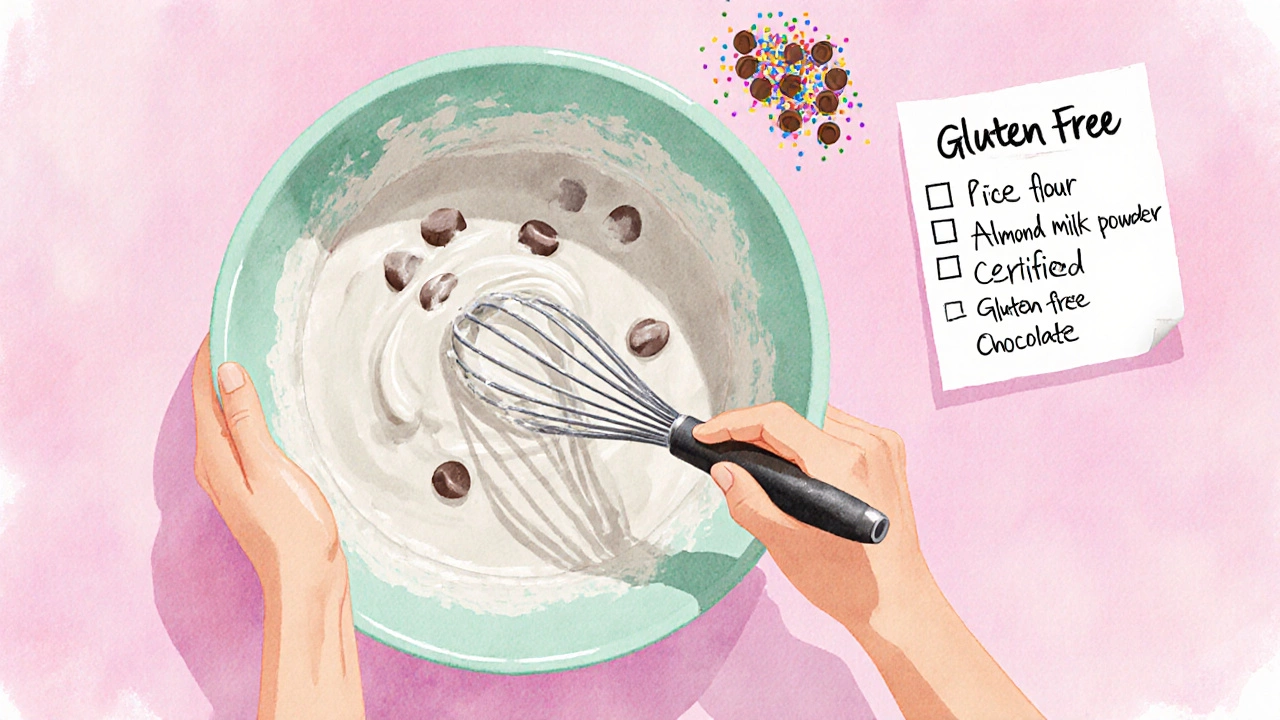Gluten Content Calculator
Calculate Gluten Exposure
Determine how much gluten you're consuming from common ingredients. Enter the amount of food you're using and select the ingredient from our reference table.
Enter ingredient and quantity to see gluten content.
Trying to keep your cakes truly gluten‑free? Knowing which everyday foods are packed with gluten is the first step. Many people assume only wheat is the culprit, but a whole family of grains and processed products can send gluten levels soaring. Below we break down the biggest sources, give you a handy reference table, and share tips to keep hidden gluten out of your batter.
Understanding Gluten
Gluten is a protein network formed by gliadin and glutenin found in certain cereal grains. When mixed with water, it creates the stretchy matrix that gives dough its elasticity and helps baked goods rise. For people with celiac disease or gluten sensitivity, even tiny amounts can trigger symptoms.
Core Grains That Naturally Contain Gluten
Not all grains are created equal. The following staples are naturally high in gluten and should be avoided in any gluten‑free cake recipe.
- Wheat is the most common source of gluten, with gluten making up roughly 10‑15% of the grain’s dry weight.
- Barley contains about 5‑7% gluten and is often found in malted products, beers, and breakfast cereals.
- Rye provides 2‑4% gluten, giving rye breads their dense texture.
- Spelt is an ancient wheat relative; its gluten content is similar to modern wheat, around 12%.
- Durum Wheat is the hard wheat used for pasta; it holds about 12‑14% gluten.
- Triticale is a hybrid of wheat and rye, packing 10‑12% gluten.
- Kamut (also called Khorasan wheat) carries roughly 12% gluten.
- Farro is a hulled wheat variety with a gluten content close to 10%.
Processed Foods That Concentrate Gluten
Even if a product doesn’t list a grain on the front, gluten can be lurking in concentrated forms. Here are the biggest offenders:
- Seitan is a meat substitute made almost entirely from wheat gluten; it’s essentially pure gluten.
- Wheat flour (all‑purpose, bread, cake, and whole‑wheat) - the base for most baked goods.
- Wheat starch - often added as a thickener in sauces and gravies.
- Pasta and noodles - usually made from durum wheat.
- Breakfast cereals and granola bars - many contain malted barley or wheat flakes.
- Crackers, pretzels, and some seasoned chips - commonly wheat‑based.
- Soups and bouillon cubes - may include wheat flour as a flavor enhancer.
Gluten Content Reference Table
| Food | Gluten (g/100 g) | Typical Uses |
|---|---|---|
| Wheat flour (all‑purpose) | 10‑12 | Baking, thickening |
| Durum wheat (semolina) | 12‑14 | Pasta, couscous |
| Barley (malted) | 5‑7 | Beer, malted milk |
| Rye flour | 2‑4 | Rye bread, crispbreads |
| Spelt flour | 10‑12 | Artisan breads, pastries |
| Seitan (wheat gluten) | ~75 | Meat substitute |
| Wheat starch | ~1‑2 | Thickener, coating |
| Kamut flour | 12‑13 | Specialty breads |
How to Spot Hidden Gluten When Baking
- Read labels carefully. Look for terms like "malt," "hydrolyzed wheat protein," "modified food starch," or "wheat germ."
- Check the ingredient list of any pre‑made mixes - even “gluten‑free” claims can be false if cross‑contamination isn’t disclosed.
- Beware of flavorings and spices; some powdered sauces use wheat flour as a filler.
- Use dedicated gluten‑free cookware and storage containers to avoid cross‑contact.
- When dining out, ask the baker if they use any gluten‑containing dough conditioners or improvers.
Quick Checklist for Gluten‑Free Cake Prep
- Swap wheat flour for a 1‑to‑1 gluten‑free blend that includes rice flour, tapioca starch, and xanthan gum.
- Replace malted milk powder with almond or oat milk powder (make sure the oat version is certified gluten‑free).
- Avoid dark soy sauce and any sauces labeled “reduced‑sodium” - they often contain wheat.
- Use certified gluten‑free chocolate chips, nuts, and dried fruits.
- Double‑check packaged décor like sprinkles; many contain wheat starch.
Why It Matters for Cake Lovers
Even a tiny speck of gluten can ruin a cake for someone with celiac disease - the reaction can be immediate and severe. By knowing which foods are truly high in gluten, you eliminate guesswork and protect your guests. Plus, mastering gluten‑free swaps often leads to lighter textures and brighter flavors, a win‑win for everyone.
Can I eat whole‑grain breads if I’m gluten‑free?
No. Whole‑grain breads are usually made from wheat, barley, rye, or spelt - all high‑gluten grains. Look for breads labeled “gluten‑free” that use rice, millet, or buckwheat flours instead.

Is oat flour safe for celiacs?
Pure oats are gluten‑free, but most commercial oat products are processed alongside wheat. Choose oats that are certified gluten‑free to avoid cross‑contamination.
What’s the difference between wheat starch and wheat flour?
Wheat flour contains the full protein‑gluten network, while wheat starch is mostly carbohydrate with only trace gluten. However, even the small amount can add up, so it’s still unsafe for strict gluten‑free diets.
How can I test my kitchen for hidden gluten?
Use a gluten test kit - it works like a pregnancy test and can detect trace gluten on surfaces, utensils, or in finished batter.
Are there any natural sweeteners that contain gluten?
Most natural sweeteners (honey, maple syrup, agave) are gluten‑free. Watch out for flavored syrups that may include malt extract.